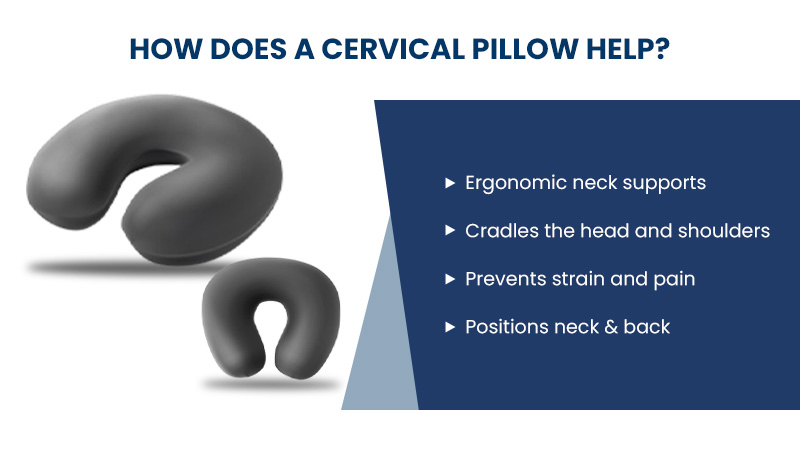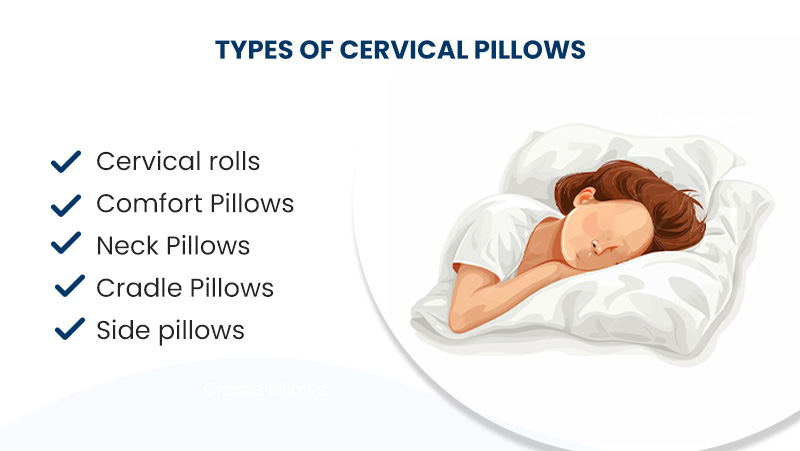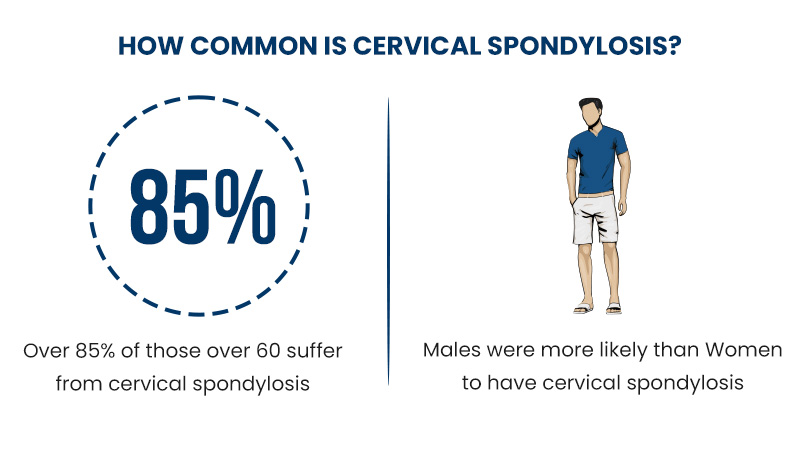Neck pain isn’t precisely news nowadays. Since our work routines collided with our sleep schedule, we have all been experiencing bodily discomforts daily. The most common and uncomfortable of all is neck pain. Frequent pain in the neck can lead you to suffer through problems like cervical or spondylitis.
If you sleep funny or your pillow isn't supportive enough, you may be prone to neck pain more often. There are several reasons why someone could experience neck discomfort, including stress, bad posture, texting, sports injuries, auto accidents, and chronic conditions like fibromyalgia.
Pillows alone can have a significant impact on your sleep quality. Hence, buying the best pillow for cervical neck pain becomes necessary. Let’s discuss this entire process at length so that you get a better understanding of cervical pain and what you can do to prevent it.
Best Cervical Pillow for Neck Pain
By preserving the spine's natural curvature, you can sleep comfortably, so a cervical pillow can work wonders. Many of these pillows are available in various materials and shapes, so you may select the one that suits you the best. Now, let's examine the reasons for neck discomfort and learn more about the benefits of a neck pillow for cervical pain.
How does a Cervical Neck Pillow help?
Cervical pillows of specific design work to align the neck as it sleeps, cradle your head and shoulders, and support and keep them in the appropriate position. The correct angles will help you relax when resting your head and neck, reducing the probability of strain and, thus, pain when you wake up.
The ideal positions for your head and neck will change depending on whether you sleep on your side, back, or stomach. A cervical pillow that compresses the area where the headrests and rises to the level of the neck is what you need.
Memory foam, which compresses and decompresses around the neck and head, is typically used to make cervical pillows. It offers superior ergonomic support and a restful night's sleep.

Types of Neck and Cervical Pillows
Cervical rolls
Cervical pillows are highly adaptable and can be placed beneath almost any body part, such as the head, neck, knees, or back, to ensure lumbar support and spine alignment. They are best for people with frequent neck and back problems.
Comfort Pillows
These regular pillows come in a traditional shape and feel if you prefer. They aren’t compatible with all kinds of sleeping positions, but people who are used to a lighter pillow feel while sleeping can go for this. These pillows offer better ergonomic support than the usual pillows.
Neck Pillows
Neck pillows are especially beneficial to those who sleep on their sides or back since they are designed to align your neck's natural curve. The contemporary designs of these pillows provide options for people with different body shapes.
Cradle Pillows
To relieve strain on your neck and spine, pillows with cradle support will be perfect for balancing your head. It also helps to keep your breathing cycle intact and reduces snoring.
Side pillows
The curving edge of these pillows is lower in the center and higher on the side, properly aligning the neck with this design. The front edge of the side pillows is angled forward, cradling the top vertebrae. Additionally, this frontal curvature gives your shoulders room and adds comfort to this area.

Can a Cervical Pillow Help with Neck pain?
Yes, a cervical pillow is fitting for your neck problems. A neck pain cervical pillow is designed to cradle your neck and head in a way that accurately aligns with your spine. It will help you keep the natural cervical curvature intact while you sleep, thus preventing any neck strain or stiffness.
A customized cervical pillow offers posture correction. Because more blood flows to your head, it also helps you sleep better by releasing and relaxing stiff muscles in your neck and shoulders. A lousy pillow choice might lead to a wrong neck position.
When someone wakes up with neck pain due to improper body support, it's generally an indication of a difficult day ahead. Poor blood circulation can cause headaches, numbness in the arms or hands, and muscle stiffness in the neck and shoulders.
That's a stretch, isn't it? Headache episodes connected to the neck might occasionally be caused by upper cervical spine tension. Lower cervical spine discomfort is the root cause of shoulder and arm pain.
What is the best pillow for side sleepers with Neck Pain?
Some acknowledge that they have to replace a pillow if the stomach causes displacement of their cervical curve or surgery. Let's discuss cervical pillows for side sleepers and how they can be more comfortably used for those who have lost cervical curvature.
The cervical curve refers to your neck's natural curve when lying supine. That is why your head and neck are not aligned. A pillow that supports your head and neck neutrality should help prevent headaches and other issues caused mainly by sleeping on the side, back problems, and neck pain.
Choosing the pillow that is the most comfortable for you from the various options set up for the particular head and neck regions is critical. To be exact, three types of pillows can be used by sleepers who are lying on their side and also have lost their neck curve:
The wedge pillow is primarily placed between the legs and the shoulder blades. When lying on the side, the best thing to do is always to keep a stable and straight line from head, neck, and back through the entirety of your body.
A hybrid pillow consists of two sections: a bottom component that rests on top of the chest and an upper segment that rests on top of the head. While the bottom section's bumps, which may be employed alone or for wedging, aid in maintaining the upper body in a neutral posture, the upper section's depression supports the head's crown. Some of the top-rated cervical pillow options are:
- Pillow cases and covers
- facial or skull pillows
- body pillows and shams
- neck roll pillows and head rolls
- neck rolls only
- under-the-shoulder roll pillows
- protrusions to support the back and sides of the body (lumbar roll)
Cervical neck supports are some of the common types of pillows available. Additionally, you may purchase foam-filled pillow inserts, such as filler blocks or sleeves, to place within pillows.
Eli & Elm side sleeper pillow has a contoured design, especially to offer adequate support to side sleepers. It conforms to the precise curvature of the head and neck, helping maintain the natural curves of the neck and spine so that you wake up pain-free and fresh.
What is Cervical Spondylosis?
The common word for wear and strain that affects your cervical spine is cervical spondylosis. Your neck's seven stacked bones, or vertebrae, are called cervical. When portions of your spine start to deteriorate, you have spondylosis. In basic terms, cervical spondylosis is also known as the “arthritis of the neck.”
Medical professionals may refer to it as arthritis or osteoarthritis of the neck. Cervical spondylosis can cause stiffness, pain, or aches in the neck. Although cervical spondylosis cannot be cured, medical experts suggest specific treatments to prevent or reduce it.
Symptoms of Cervical pain
Symptoms of Cervical spondylosis are:
- Neck pain.
- Stiff neck.
- A bump or knot in your neck.
- Muscle spasms.
- A clicking, popping, or grinding sound when you move your neck.
- Dizziness.
- Headache.
According to the Cleveland Clinic of Cleveland, Ohio, you might be suffering through the cervical, and you might not even know, which means the cervical can come without symptoms, too.

What are the causes of Cervical pain?
There are several causes of neck or cervical pain, some medical and others triggered by bad posture and sleeping on the wrong pillow or mattress. Let’s examine each cause individually to get to the root of your discomfort.
Medical Causes
1. Dehydrated Discs
Spinal discs act as a cushion or soft support between the spine's vertebrae. As you grow to about 40 years old, the discs start to shrink and dry out, reducing the support, and the bones between the vertebrae tend to rub off each other.
This entire process loosens the spine support, thereby giving rise to pain usually known as “spondylitis.” Patients who suffer from spondylitis experience extreme difficulties rotating their necks correctly. Some people also experience nausea and dizziness when they move their heads too much.
2. Herniated Discs
Wear and tear can also occur outside spinal discs, letting the soft interior squeeze through these cracks. Moreover, these cracks press against the spinal cord and nerves, which can cause extreme pain and discomfort, especially if you are a back sleeper.
People with herniated discs suffer from intolerable puncturing discomfort in one part of the body, particularly the leg, hips, or the back of the thigh. The patients have also stated that in some parts, they have no sensation of the body. Sometimes, pain will occur in the back or bottom of the calf, and numbness is also dominant in some people.
3. Ligament Stiffness
Ligaments are much like wires made of tissue that link or connect the bones. Spinal ligaments can become stiff with age, making neck movement quite tricky. Not just this, stiff ligaments can also give rise to chronic neck and spinal aches. Joint pain is quite common due to ligament stiffness. Muscle stiffness is the sensation of tight, cramped, or painful muscles.
4. Bone Spurs
Smooth, bony growths called osteophytes are frequently seen near joints. They gradually manifest in people who have arthritis or joint injury. Bone spurs often occur on the hands, feet, knees, and spine.
An active lifestyle can postpone discomfort, stiffness, and restricted range of motion. Surgery, physical therapy, and medication could be helpful. Osteophytes are most frequent in the foot, namely in the heel, big toe and ankle, hand or finger, hip, knee, neck, shoulder, and spine. However, they can sprout from any bone.
Other Causes
1. Choice of Pillow
A pillow that is too small or too large might strain the muscles in your neck, leading to neck pain. Therefore, if you have neck discomfort, it is best to switch pillows or use an orthopedic pillow, especially if you have cervical disease or the pain lasts for a long time.
2. Sleep Position
Everyone has a favorite way to sleep. However, sometimes, the incorrect position you choose to sleep in may lead to trouble. To illustrate, lying on your belly may cause your head to turn to one side for long periods, stretching your muscles and stiffening you in the morning. The back may also be strained when sleeping in this posture. So, it is essential to avoid this sleeping position.
3. Quick Movements or Strains
Occasionally, abrupt motions such as throwing your arms, swiveling excessively as you sleep, or prolonged periods of inactivity or positional shifts might cause strain and stress in your neck. Due to specific sports or accidents, you may experience this problem after a few days.
How Common is Cervical Spondylosis?
Surprisingly, cervical spondylosis is very common nowadays. The constantly hectic work routines and disrupted sleep cycles have led cervical problems to creep into our lives quite easily. Cervical issues can get worse as we get older. Hence, we must be careful about our health and try to get such problems diagnosed early in the stage.
Over 85% of those over 60 suffer from cervical spondylosis. Early diagnosis will allow us to address these issues with sufficient time. Research that was published in the Journal of the American Geriatrics Society indicates that males are more likely than women to have cervical spondylosis.
The study discovered that across all age categories, males were more likely than women to have cervical spondylosis. However, as people age, the gender difference closes, and by the time people are 70 years old, both men and women have identical prevalence rates.

Why is it more Common in Men?
There are several possible explanations for why males are more likely than women to develop cervical spondylosis:
Occupation
Men are more prone to work in physically demanding jobs or participate in repeated activities, such as heavy lifting, extended sitting, and repetitive neck motions, that can cause wear and strain on the cervical spine.
Biomechanical Differences
Men may be more prone to cervical spondylosis due to differences in the biomechanical properties of their cervical spine when compared to women.
Lifestyle
Cervical spondylosis may develop due to certain lifestyle variables, which may be more common in men. These causes include smoking, obesity, and bad posture.
Genetic Predisposition
Men may be more likely than women to develop cervical spondylosis due to hereditary factors. These elements may have a role in the greater incidence of cervical spondylosis in males than in women, either separately or in combination.
How can I prevent Cervical Spondylosis?
Cervical spondylosis is often an age-related condition. Here are some ways to look after your neck:
- Taking frequent pauses from neck-stressing activities, such as moving your head up or down for extended periods or holding your neck in an unpleasant or awkward posture.
- Ask your doctor about neck-strengthening and stretching activities.
- Over-the-counter painkillers, rest, ice, or heat therapy can treat moderate neck discomfort.
When Should I Seek Medical Care?
You must consult a physician or medical professional if the pain or muscle doesn’t go away or worsen over time. If you are already suffering from cervical spondylosis and are undergoing treatment but your condition is not improving, you should also seek advice from your doctor for further treatment.
Final Thoughts
By preserving the spine's natural curvature as you sleep comfortably, a cervical pillow helps the spine. Many of these pillows are available in various materials and shapes, so you may select the one that suits you the best. A cervical pillow that compresses the area where the headrests and rises to the level of the neck is what you need.
Because more blood flows to your head, it also helps you sleep better by releasing and relaxing stiff muscles in your neck and shoulders. Eli & Elm's cooling side sleeper pillow has a contoured design that offers adequate support to side sleepers by conforming to the precise curvature of the head and neck.
Everyone has a favorite way to sleep, but choosing the incorrect position occasionally might get you into trouble. Over-the-counter painkillers, rest, ice, or heat therapy can also help treat moderate neck discomfort.






















